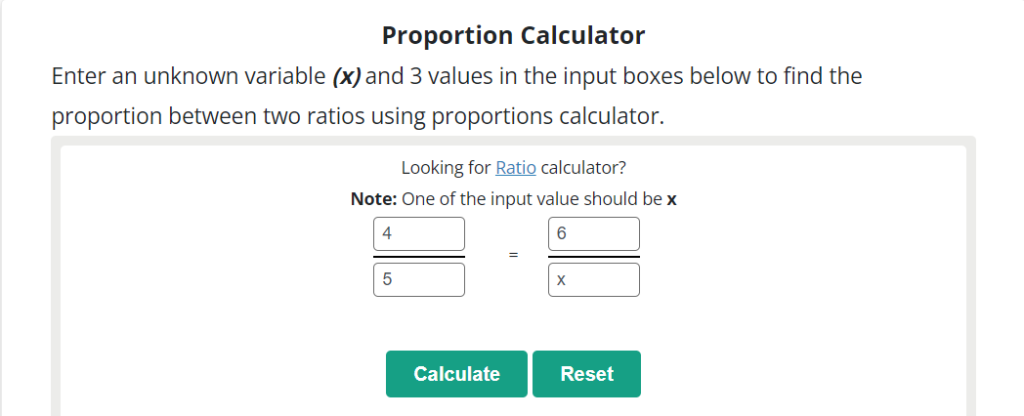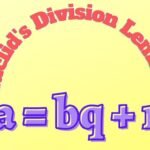Proportion is based on fractions. The fraction is written as a/b and the ratio is a: b, whereas the proportion is defined as the equality between two ratios. Proportions are a very important concept in mathematics and other social sciences. In real life, the concept of proportions is used in business when we deal with money exchange, and at home when we cock some dishes we use the concept of proportion.
Concept of Ratio in Math
Before we discuss the proportion, we have a basic idea about the ratio. The ratio is defined as the comparison of two quantities that have the same units. It is denoted as ‘:’. For example, if the height of flag A is 200 cm and the height of flag B is 4 m.
Then the ratio between flag A to flag B is not 200 cm : 4 m. Our first task is to make the units the same in ratio for comparison of heights. We do the conversion of 200 cm in meters by dividing it by 100. Now the height of flag A is 2 m and the height of flag B is 4 m. Now the ratio between flag A to flag B is 2m : 4 m. In the simplest form, it can be written as 1 : 2. It means that the height of flag B is double the height of flag A. Note “Ratio has no unit”.
What is Proportion?
The proportion is defined as the equality between two ratios or fractions. In another way, it is the equation that informs us how two ratios are equal to each other. The notation of proportion is ‘::’ or ‘=’. When two ratios are equal we say that they are proportional to each other.
In mathematical notation, if two ratios are equal to each other like a : b and c : d
Then in the proportion way we write it as a : b :: c : d or a : b = c : d.
- a and d are called extremes.
- b and c are called means.
Note: Product of extremes = Product of means
Types of Proportion
The main types of proportion are the following.
- Direct proportion
- Inverse proportion
- Compound proportion
- Continues proportionDirect proportion
1) Direct Proportion
A proportion is said to be a direct proportion if one quantity is increased then the other will also increase or if one is decreased then the other also decrease. For example, the relation of income of a school is directly proportional to the number of students in the school.
If the number of students increases then the income of the school increases and if the number of students of the school decreases then the income of the school will be automatically decreased.
2) Inverse Proportion
A proportion is said to be inversely proportional if one quantity is increased then the other is decreased or if one is decreased then the other is increased. For example, the relationship between workers and the days of competition of the project is inversely proportional to each other.
If the number of workers is increase then the project will be finished in fewer days. if the number of workers is decreased then the days of the project are increased.
3) Compound Proportion
The compound proportion is defined as the proportion that involves two or more than two proportions. For example, the relationship between the number of men, working hours, and income is a compound proportion.
4) Continues Proportion
The continuous proportion is defined as in which the consequent of the ratio is the antecedent of the next ratio. If a : b= b : c, where a : b the term a is called antecedent and b, is called the consequent.
How do We find an Unknown Variable in Proportion?
We know that proportion is an equation so we can find the unknown term or variable which is involved in proportion. For example, a: b = c: d if a is unknown then we change it in the form of fraction a/b = c/d. and then a= b*c/ d. The unknown variable of the proportion can be determined either by using a formula or a proportion calculator.

Example 1: Find the unknown variable x in the given proportion 2 : 4 :: 20 : x.
Solution:
Step 1: Write the given proportion
2 : 4 :: 20 : x
Step 2: Change into the form of fractions
2/4 = 20/x
Step 3: Now cross multiply
2x = 80
x = 80/2
x = 40
Example 2: If in an office 20 men are working together 8 hours daily to complete the task. if 10 men go back to their homes then how many hours are required to complete the same task?
Solution:
Step 1: Find the number of men left
20 – 10 = 10 men
Step 2: Write the given date in mathematical form
Men: hours
20 : 8
10 : x
20 : 8 :: 10 : x
Step 3: It is an inverse proportion.
20/10 = x/8
Step 4: Cross-multiply these terms.
20 *8 = 10 * x
x = (20 * 8)/10
x = 16 It means that 10 men work 16 hours to complete their tasks.
Example 3: Find the x where 5 & 125 is continuous proportion.
Solution:
Step 1:
By the definition of a continuous proportion
5 : x :: x : 125
Step 2:
By applying the rule “Product of means is equal to Product of extremes”.
x2 = 5*125
x2 = 625
Step 3:
Now take square root on both sides
x = ± 25 Its shows that the continuous proportion is ± 25.
Example 4: Solve the Proportion 2 : 2 = x : 10.
Solution:
Apply the rule “Product of means is equal to Product of extremes”
2*10 = 2*x
2x = 20
x=10
Summary:
In this article, we have learned about the definition, formulas, types, and examples of proportions. We are also able to solve a real-life problem and find the proper solution to the problem.


















































































































































